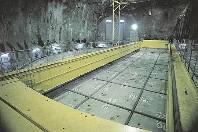Moves for waste disposal
06 April 2009
Bulgaria has moved closer to a solution for the main portion of its radioactive waste with a contract to select a site for disposal.
 |
Underground storage of ILW as
practiced by Sweden's SKB |
A consortium led by VT Nuclear Services is to take on the project to select a site for a national disposal facility for low-level and intermediate-level radioactive waste (LLW and ILW). The contract for the work worth €2.6 million ($3.4 million) has been awarded by Bulgaria's State Enterprise for Radioactive Waste (SE-RAW).
VT Nuclear Services was formerly the Project Services arm of British Nuclear Group, purchased by VT from the UK government's BNFL in January 2008. With its partners, Empresarios Agrupos International and ENPRO Consult, the company will establish a project management unit for site selection, design, safety assessment construction and commissioning of what will be called the National Disposal Facility for LLW and ILW.
In 2005 the Bulgarian Council of Ministers decided that a 50,000 cubic metre repository would be required for LLW and ILW and directed that this should begin operation by 2015.
The near-surface facility will be a repository, which means that waste packages could be removed in future if necessary. The consortium will select a suitable site and prepare environmental impact assessments, as well as manage the technical design of the facility and manage the public consultation process.
The wastes in question will primarily come from Bulgaria's Kozloduy nuclear power plant, at which two operating reactors produce 35% of the country's electricity. The site also features four shut down power reactors. The plant contributes 3% of the average market price of its power into a radioactive waste fund that will be used for this project.
Low-level waste is typically composed of things like clothes, filters, and equipment used routinely at nuclear sites. It is usually placed in drums that are then compacted. Intermediate-level waste (ILW) contains things like resins, chemical sludges and metal fuel claddings which have higher levels of radioactivity and require shielding.
The other category of radioactive waste to be managed separately is high-level waste (HLW), which is the reactor fuel after use and the waste streams after its reprocessing. The key difference between LLW, ILW and HLW is that only HLW produces heat and that HLW represents a tiny fraction of all radioactive wastes but contains the bulk of the radioactivity wheras the ratios are reversed for the other types.